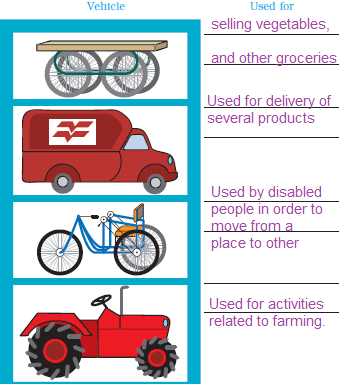How do we go from one place to another? This lesson deals with the means of transport. It discusses the modes of transport, the number of wheels in each of them, who drives them, etc. Here, we are providing you with the best and most detailed NCERT Solutions For Class 3 EVS Chapter 11 From Here to There.
The NCERT Solutions for Class 3 have been designed meticulously by our team of experts. Download these solutions in PDF format and let your kid practise all the questions in the textbook from a reliable resource.
NCERT Solutions For Class 3 EVS Chapter 11 From Here to There
Access Answers to NCERT Class 3 EVS Chapter 11 From Here to There
THE TRAIN
Question 1:
How did you like the poem?
Answer:
I loved the poem.
Question 2:
Have you ever travelled in a train? When?
Answer:
Yes, I travel in a train every time we go to my grandma’s place in the summer holidays.
Question 3:
Can a train move anywhere? Why?
Answer:
No, a train cannot move anywhere. It can move only on the rails or the tracks.
Question 4:
What is meant by ‘roads of iron’?
Answer:
Roads of iron means iron rails on which the train moves.
Question 5:
What places did the train pass by? Make a list.
Answer:
The train passed by meadows, over the hills, farmers, temples, mills, village wells and a lush green field and a potato field.
Question 6:
Which vehicles have you travelled in? Write their names in your notebook.
Answer:
I have travelled in a bicycle, bike, auto, car, bus, train and aeroplane.
Question 7:
Which all vehicles did the children travel in?
_______________ _______________ _______________
_______________ _______________ _______________
_______________ _______________ _______________
Answer:
Children travelled in:
1. Bus 2. Train 3. Car
4. Flight 5. Taxi 6. Cycle
7. Boat 8. Horse 9. Rickshaw
Question 8:
How would you choose to go from your house to the places written below? Write in the box.
Answer:

Question 9:
Write in front of each picture what the vehicle is used for. In the spaces provided, draw the pictures of some other vehicles. Write their names and what they are used for. Are all these vehicles used for our travel?
Answer:


Question 10:
Names of some vehicles are given in the centre of a wheel. Join these on one side to the number of wheels each vehicle has and on the other, join them to what is used to run them.
Answer:
| Vehicle | Number of Wheels | Driven By |
| Bus | 4 or more than 4 | Humans, diesel/petrol |
| Bullock-cart | 2 | Animals |
| Cart | 2 or 4 | Humans |
| Scooter | 2 | Humans, petrol/diesel |
| Rickshaw | 3 | Humans |
| Car | 4 | Humans, petrol/diesel/gas |
| Metro Rail | More than 4 | Humans, electricity |
| Train | More than 4 | Humans, petrol/electricity |
| Boat | None | Humans |
| Truck | 4 or more than 4 | Humans, petrol/diesel |
| Bicycle | 2 | Humans |
| Motorcycle | 2 | Humans, petrol/diesel |
Question 11:
Find out from your elders – How did people travel fifty years ago? Were the present means of travel available at that time also?
Answer:
Fifty years ago, our elders travelled in bullock-carts, buses, trains, cars, taxis, bicycles, etc. Yes, some of the current modes of travel were available at that time, such as cars, buses, trains, taxis, etc.
Question 12:
Can you imagine which vehicles people will use for travel twenty years from now? Ask your family members and friends and fill in the table. You can add more –
Answer:
| Whom You Asked | Their Answer |
| You | Solar-powered bicycles |
| Friend | Battery/electricity motorcycles |
| Chacha | Solar-powered cars |
| Teacher | Electronic public transports |
| Mummy | Electronic small cars |
| Daddy | Solar-powered taxis |
YOUR OWN TRAIN
Question 1:
If anybody makes a ‘chhuk-chhuk’ sound you know at once that it is being made for a train. From the sounds given below can you tell which vehicle it is? One example is given.
Answer:
| Chhuk-chhuk | Train |
| Peen-peen | Scooter |
| Pon-Pon | Truck |
| Tup-tup | Horse-cart |
| Gharr-gharr | Motorcycle |
| Tring-tring | Bicycle |
Question 2:
These are the sounds of single vehicles. How does it sound when many vehicles run together on the road making different noises? Isn’t there a lot of noise?
Answer:
Yes, there is a lot of noise. When many vehicles run together on the road, it gives a collective disturbing sound.
Question 3:
Where have you heard the maximum noise?
Answer:
At the traffic signals.
Question 4:
Do you like so much noise? Why?
Answer:
No, I don’t like so much noise because it is very disturbing.
Question 5:
What all can you see in the picture?
Answer:
In the picture, a building has caught fire. The firemen are trying to put it out. There are 2 fire trucks, a police van and an ambulance.
Question 6:
Which vehicles can you see in the picture?
Answer:
Fire-trucks, police-van and ambulance.
Question 7:
What are these vehicles usually used for?
Answer:
Fire trucks (fire-brigade van) are used by firemen to go anyplace which has caught fire. The fire-trucks contain a lot of water, ground and aerial ladders, etc.
A police-van is used by policemen to move from one place to another.
An ambulance is used to carry patients.
Question 8:
Look at the boxes in the picture on the top.
Draw them in the correct sequence in the bottom boxes and colour. What did you get? Write its name.
Answer:









Comments